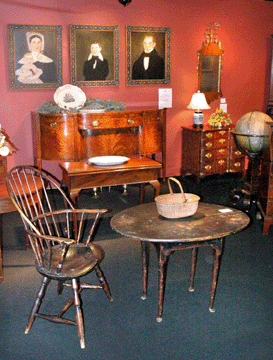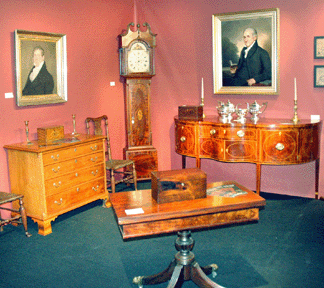
If you happened to be in the market for an antique tall case clock, then you should have been in Wilmington for the 43rd annual Delaware Antiques Show that previewed Thursday evening, November 9, and continued for the next three days. In total, 34 clocks stood about the Chase Center on The Riverfront, a facility the show has been in for the past five years.
But more about the clocks later. Word from the show’s manager, Marilyn Gould, is that the gate for the show was up, with most of the gain taking place at the preview, and there was some active buying during those popular hours of the show. “I have not heard from the majority of the exhibitors, as yet, but so far it looks like everyone wants to return for next year,” Marilyn said. A good number of the dealers mentioned on Friday morning that there seemed to be more interest than usual and expected some “be-backers” before the Sunday closing.
Cheryl and Paul Scott of Hillsborough, N.H., reported that a man called them two hours before the show was closing on Sunday and wanted to buy the New Hampshire Hepplewhite four-drawer chest, high feet, circa 1810, red surface, that he had admired at the preview. He came back, bought the chest, and was unable to take it with him as it missed by two inches fitting into his vehicle. “He ended up shipping it to Carolina where he lived,” Cheryl said. An American dressing mirror in very strong tiger maple, heart cut-outs on the supports, circa 1810, was displayed on the chest.
Kelly Kinzle of New Oxford, Penn., topped the tall case clock list with seven examples including a rocking father time from Baltimore, William Thompson, that “has never been out of the Turner family,” Kelly said. A large oil on canvas, 1885, by Carl Weber, showed a very peaceful scene with four sheep in a meadow.
“They are really ugly Americans and I would hate to be related to them,” Wayne Pratt of Woodbury, Conn., said of a trio of portraits of the Brown family, Ayer Centre, Mass., depicting father, mother, son and daughter. The pictures, measuring 28 by 33 inches, oil on canvas, date circa 1840–50. At the front of the booth, with a grouping of case pieces in the back row, was a Queen Anne grain painted tea table, maple throughout, New England, circa 1740–60.

Philip H. Bradley, Downingtown, Penn., displayed four tall case clocks, one of Delaware origin in walnut, eight-day works and signed “Duncan Beard.” It dated circa 1770 and measured 108 inches tall. In pristine condition was a Baltimore or Washington paint-decorated Windsor settee, circa 1810, that measured 36 inches high, 40 inches wide and 14 inches deep.
Diana H. Bittel Antiques, Bryn Mawr, Penn., offered a New England chest on chest with four graduated drawers over three long drawers, carved scalloped molding over the lower section, ogee bracket feet, circa 1785, measuring 39 inches wide, 76 inches high and 18 inches deep. A collection of 18 Sailor’s Valentines decorated all the walls, and among the British sailor’s woolwork pictures was one of the H.M.S. Queen leaving Plymouth Sound on August 19, 1844. It measured 38 by 31 inches and was in the original bird’s-eye maple frame.
A set of eight Chippendale side chairs in walnut, pierced splats, Philadelphia School, 1775–1790, was on the left side of the booth of Nathan Liverant and Son, Colchester, Conn., on preview night, and gone the next morning. “The set sold very fast at the preview,” Arthur Liverant said, “and each one was signed in period ink with the name of ‘Abraham Lott.'” Also sold was a Chippendale mahogany wing back chair with molded front legs and boldly flaring rear legs, slip seat construction, also Philadelphia School, circa 1750–65. It was in excellent condition, shown without any upholstery. Of Pennsylvania origin, possibly York or Lancaster County, was a polychrome paint decorated blanket chest on bracket feet, circa 1820–40.

James L. Kilvington of Dover, Del., offered a paint-decorated dower chest, Berks or Lebanon County, circa 1800–1820, that was once in the collection of Titus Geesey. Among a selection of long guns was one by George Fay, circa 1811, Pennsylvania origin, shown with a Hudson River Valley fowling piece, circa 1750–60.
George and Debbie Spiecker of North Hampton, N.H., had a nice flattop high boy, American, Queen Anne with flaring cornice over five-drawer top, attributed to the Salem, Mass., area. The piece retained the original hardware and rested on cabriole legs ending in pad feet. An American tiger maple Hepplewhite corner cupboard, circa 1810, had doors with eight lights each over two doors and resting on high arched feet.
One of the dealers in the large entrance room where the cafeteria was in operation was Dixon-Hall Fine Art of Phoenixville, Penn. Among the painting that covered the walls was an oil on canvas, 24 by 36 inches, by John Horace Hooper (British, late Nineteenth Century), “View on the Thames.” It was signed lower right. Charles H. Clair (French, 1860–1930) painted an oil on canvas, signed lower right, ‘Morning,” depicting a barnyard with sheep and measuring 25 ½ by 36 ¼ inches.
Philadelphia dealer M. Finkel and Daughter had needlework hanging everywhere, including a sampler by Orpah P. Lewis, Chester County, dated 1825 and featuring a poem written to her parents. Furniture included a set of eight Philadelphia fancy side chairs with rush seats, original paint, circa 1830, attributed to John W. Patterson.

Among the textiles hung in the booth of Jan Whitlock, Chadds Ford, Penn., was a whimsical album quilt with birds in silk and velvet, along with an Amish nine-patch quilt from Lancaster County, circa 1940, in pleasing colors, wool and cotton.
The Dunlap School, New Hampshire, was represented in the booth of Peter Sawyer, Exeter, N.H., by a Queen Anne high chest of drawers with a finely carved “linen fold” fan, central pinwheel, and the original brasses. A tiger maple six-drawer chest of New England origin, circa 1790, was unusual in that the top was also of tiger maple.
A country stand-up desk with applied molding at the top, interior drawer and cubbyholes, cutout base and in the original painted surface was at the end of the booth of Peter H. Eaton/Joan R. Brownstein, Newbury, Mass. It was probably from Vermont, circa 1820. A fine country Chippendale tiger maple desk with ogee bracket feet, Southeastern New Hampshire, circa 1785–1800, had a tag that read circa 1785–18000. “Just goes to show the longevity of antiques,” Peter Eaton explained. Among the works of art was “The Bay of New York,” with a view of Castle William on Governor’s Island, complete with ships in the harbor, an oil on canvas measuring 29 by 36 inches and in the original circa 1845–50 gold ripple frame.

G.K.S. Bush, Miami Beach, Fla., offered a small Baltimore settee, Sheraton, circa 1820, in vibrant red with gilt decoration, and several pairs of figural andirons, including two with dogs and one with fish. “Folk art on fire,” Guy said of the display.
“That’s an interesting pair of chairs,” Skip Chalfant of West Chester, Penn., said of the two walnut Queen Anne side chairs with shell-carved knees, another shell on the crest, cabriole legs, circa 1760, of Philadelphia origin. He mentioned that two years ago his shop was broken into and the chairs were stolen. A pick-up truck with Wyoming plates was seen in the area and later the chairs were bought at a flea market in Colorado. “A month ago the chairs came up at a New England auction and I was able to buy them back,” Skip said. Other seating in his booth included a Windsor fanback armchair with carved ears, D-seat, vase and ring turnings, with salmon paint under Nineteenth Century black paint. The chair was of Philadelphia origin, circa 1770.
Early sales at the booth of Norma Chick, Autumn Pond, Woodbury, Conn., included two weathervanes, a gamecock and an eagle, and a delft tile fireplace surround depicting sea creatures. In total, eleven vanes were offered.

Elizabeth Garrison of Pitts Grove, Salem City, N.J., was the creator of a large sampler, wool on linen and dated 1844, that hung in the booth of Stephen and Carol Huber of Old Saybrook, Conn. A Massachusetts silk and watercolor memorial, circa 1870, was by Sophia Barney.
“We owned that eagle many years ago and were able to buy it back from the Ford Collection at Sotheby’s,” Ed Hild of Olde Hope Antiques, New Hope, Penn., said of the carved and painted figure in the front of the booth. The eagle was perched on a shield and, in addition to the Ford Collection, it was once owned by George Ditmar II. A fine New England hearth rug, circa 1840, was hooked and shirred wool on linen and measured 39 ½ by 79 ½ inches.
Set off to the left of the booth of Jackie Radwin, San Antonio, Texas, was a Maine chair table in the original red surface, 48 inches in diameter, circa 1810, surrounded by a set of four paint-decorated Windsor side chairs, circa 1800, also from Maine. Drawing lots of attention was a large race horse game wheel by H.C. Evans Co., Chicago, circa 1890–1900, in the front of the booth of Jeff Bridgman of Mansfield, Penn. This wheel, about five feet in diameter, had ten glass panels, each with a picture of a race horse, and a counter on top that indicated the winner. Behind the wheel the booth was hung with many early flags for which Jeff is known.

Now back to the tall case clocks. Here is the count, dealer by dealer, starting with Kelly Kinzle who offered seven. James L. Price came in second with six, followed by Philip Bradley at four. Both James Kilvington and Skip Chalfant each had three and Peter Sawyer offered two. The following dealers showed one each: Nathan Liverant and Son, Taylor B. Williams, R.M. Worth, Christopher T. Rebollo, Thomas Schwenke, Steven Still, Guy Bush, Cheryl and Paul Scott and Don Heller, bringing the total to 34.
The schedule of events surrounding the antiques show was interesting, with eight Walks with the Experts spread out over the three days. Ralph Howard, interior designer, gave a lecture on Friday titled “Decorating For Collectors: Creating Comfort and Order for Compulsive Acquirers” and on Saturday Robin Emmerson, ceramic scholar, talked about “Liverpool Pottery and the Liverpool Trade.” This talk was tied in with the loan exhibit, “Peace, Plenty and Independence,” selection from the world’s finest private collection of English pottery made for the American market during the Federal period.

